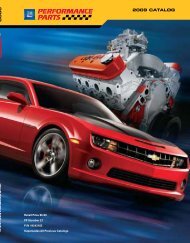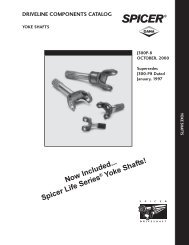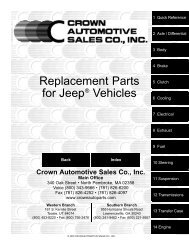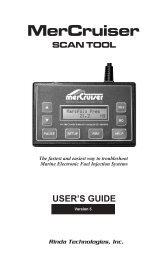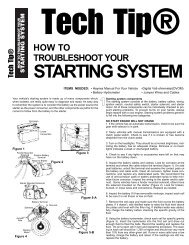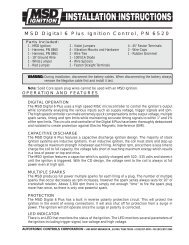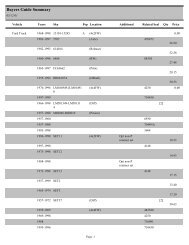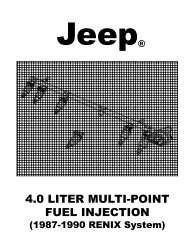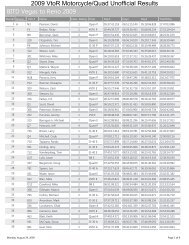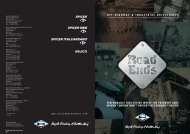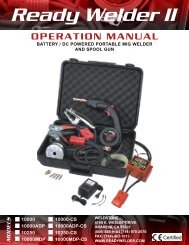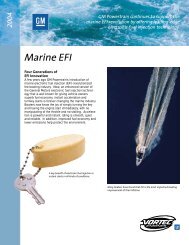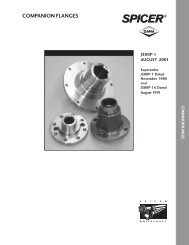Ball and Roller Bearings - Ntn-snr.com
Ball and Roller Bearings - Ntn-snr.com
Ball and Roller Bearings - Ntn-snr.com
Create successful ePaper yourself
Turn your PDF publications into a flip-book with our unique Google optimized e-Paper software.
Bearing H<strong>and</strong>ling<br />
15. Bearing H<strong>and</strong>ling<br />
<strong>Bearings</strong> are precision parts <strong>and</strong>, in order to preserve<br />
their accuracy <strong>and</strong> reliability, care must be exercised in<br />
their h<strong>and</strong>ling.<br />
In particular, bearing cleanliness must be maintained,<br />
sharp impacts avoided, <strong>and</strong> rust prevented.<br />
15.1 Bearing storage<br />
Most rolling bearings are coated with a rust preventative<br />
before being packed <strong>and</strong> shipped, <strong>and</strong> they should be<br />
stored at room temperature with a relative humidity of<br />
less than 60%.<br />
15.2 Installation<br />
When bearings are being installed on shafts or in<br />
housings, the bearing rings should never be struck<br />
directly with a hammer or a drift, as shown in Fig.<br />
15.1, because damage to the bearing may result.<br />
Any force applied to the bearing should always be<br />
evenly distributed over the entire bearing ring<br />
face. Also, when fitting both rings simultaneously,<br />
applying pressure to one ring only, as shown in Fig.<br />
15.2, should be avoided because indentations in the<br />
raceway surface may be caused by the rolling<br />
elements, or other internal damage may result.<br />
Fig. 15.1<br />
15.2.1 Installation preparations<br />
<strong>Bearings</strong> should be fitted in a clean, dry work area.<br />
Especially for small <strong>and</strong> miniature bearings, a clean<br />
room should be provided as any contamination particles<br />
in the bearing will greatly affect bearing efficiency.<br />
Before installation, all fitting tools, shafts, housings, <strong>and</strong><br />
related parts should be cleaned <strong>and</strong> any burrs or cutting<br />
chips removed if necessary. Shaft <strong>and</strong> housing fitting<br />
surfaces should also be checked for roughness,<br />
dimensional <strong>and</strong> design accuracy, <strong>and</strong> to ensure that they<br />
are within allowable tolerance limits.<br />
<strong>Bearings</strong> should not be unwrapped until just prior to<br />
installation. Normally, bearings to be used with grease<br />
lubricant can be installed as is, without removing the rust<br />
preventative. However, for bearings which will use oil<br />
lubricant, or in cases where mixing the grease <strong>and</strong> rust<br />
preventative would result in loss of lubrication efficiency,<br />
the rust preventative should be removed by washing with<br />
benzene or petroleum solvent <strong>and</strong> dried before<br />
installation. <strong>Bearings</strong> should also be washed <strong>and</strong> dried<br />
before installation if the package has been damaged or<br />
there are other chances that the bearings have been<br />
contaminated. Double shielded bearings <strong>and</strong> sealed<br />
bearings should never be washed.<br />
15.2.2 Installing cylindrical bore bearings<br />
<strong>Bearings</strong> with relatively small interference fits can be<br />
press fit at room temperature by using a sleeve against<br />
the inner ring face as shown in Fig. 15.3. Usually,<br />
bearings are installed by striking the sleeve with a<br />
hammer; however, when installing a large number of<br />
bearings, a mechanical or hydraulic press should be used.<br />
When installing non-separable bearings on a shaft <strong>and</strong><br />
in a housing simultaneously, a pad which distributes the<br />
fitting pressure evenly over the inner <strong>and</strong> outer rings is<br />
used as shown in Fig. 15.4. When fitting bearings which<br />
have a large inner ring interference fit, or when fitting<br />
bearings on shafts that have a large diameter, a<br />
considerable amount of force is required to install the<br />
bearing at room temperature. Installation can be<br />
facilitated by heating <strong>and</strong> exp<strong>and</strong>ing the inner ring<br />
beforeh<strong>and</strong>. The required relative temperature difference<br />
between the inner ring <strong>and</strong> the fitting surface depends on<br />
the amount of interference <strong>and</strong> the shaft fitting surface<br />
diameter. FIg. 15.5 shows the relation between the<br />
bearing inner bore diameter temperature differential <strong>and</strong><br />
Pressure<br />
distribution<br />
pad<br />
Fig. 15.2<br />
Fig. 15.3 Fitting sleeve<br />
pressure against<br />
inner ring<br />
Fig. 15.4 Fitting sleeve pressure against<br />
inner /outer ring simultaneously<br />
pressure against inner ring<br />
A-86



